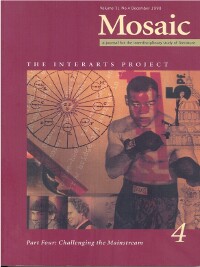Issue 31.4
Overview

Special Issue: The Interarts Project IV: Challenging the Mainstream
Published: December 1998
View the issue introduction or see the issue summary and contents below.
9 essays, totalling 192 pages
$14.95 CAD
The final issue of The Interarts Project returns to questions raised in the first and second issues that concern whether the arts were ever separate and how culture and the artist create art. Framing the issue in terms of structure and anti-structure, superstructure and base, mainstream and marginal, economics and authenticity, illusion and reality, and of artist or not, Editor Evelyn J. Hinz draws attention to the role of the critic and academic in “making art happen.” Essays in this issue address how women stage and perform cross-dressing between the public and private; musical and fictional popularism; Hans Bellmer illustrating Bataille’s pornography; the flow between be-bop jazz as poem and musical form in Langston Hughes; what Jack Kerouac, Antonin Artaud, and the Three Stooges have in common; the in-situ of in-situ words, images, sculpture, and modernism; (re)interpreting space in the architectural ekphrastic poetry of Claude Esteban; remediating violence through depictions of boxing; and the mashup of media and science in Gold Bug Variations.
Forms of Masquerade: The Art of Dora CarringtonGeneviève Sanchis Morgan Drawing upon current theorizing about the way that cross-dressing extends beyond mere gender blurring, this essay explores how British artist Dora Carrington inverted conventional notions about what should be private” and what should be “public.” Specific focus is on the implications of four trompe l’oeil artworks that she produced. | |
Music and Fiction: The Perils of PopularismBruce K. Martin Enlisting music, especially popular music, has posed an increasingly unavoidable attraction and risk for the novelist. This essay explores the ways of responding to that challenge represented by Daniel Deronda, Ulysses, and David Lodge’s Nice Work, with a view to charting the stages in the evolving relationship between popular music and fiction. | |
Pornography as Paradox: The Joint Project of Hans Bellmer and Georges BatailleElliott Vanskike In illustrating Bataille’s pornographic novels Story of the Eye and Madame Edwarda, Bellmer provided the visual equivalent of Bataille’s use of transgressive sexuality to collapse stable dialectics. Bellmer’s erotic images, rendered with drafting lines, paradoxically limn the “geometric incandescence” that Bataille sought through prose. | |
Jazzing It Up: The Be-bop Modernism of Langston HughesRobert O'Brien Hokanson Drawing on aesthetic principles rooted in the black vernacular tradition, Langston Hughes crafted a distinctively African-American poetic voice. This essay examines the ways Hughes uses be-bop jazz to challenge not only the boundaries between music and poetry but also distinctions between popular and high culture in his modernist long poem Montage of a Dream Deferred. | |
Kerouac, Artaud, and the Baroque Period of the Three StoogesDavid Sterritt As a core member of the Beat Generation group, Jack Kerouac challenged norms of conservatism, consumerism, and conformity with carnivalesque outpourings of “spontaneous bop prosody,” celebrating states of liminality and grotesquerie that are also evoked in works by sociocultural rebels as different as Antonin Artaud and the Three Stooges. | |
D’Entre Les Arts, L’in SituManon Regimbald The term “in situ” refers to contemporary aesthetic constructs in which art and nature are intermingled and where the natural objects and places are fashioned into art. Focusing on the interrelationship of words and images, this essay explores how the crisis of modernity is reflected in the work of Robert Smithson, Melvin Charney, Andy Goldsworthy, Ian Hamilton Finlay, and Richard Long. | |
Poésie critique as “Poetics of Space”: Edward Hopper and Claude EstebanAdelia V. Williams Claude Esteban’s Soleil dans une pièce vide, a collection of meditations inspired by various paintings of the American Realist Edward Hopper, departs from both traditional ecphrastic poetry and “poésie critique.” Using the insights of Gaston Bachelard, this essay explores Esteban’s phenomenological reading of Hopper’s paintings of dwellings and empty rooms. | |
Figuring and Disfiguring: Joyce Carol Oates on Boxing and the Paintings of George BellowsDaniel Morris Addressing debates about the effects of representing bodily pain, this essay focuses on writings about boxing by Joyce Carol Oates and paintings by George Bellows. Emphasis is on the way that such representation can be an act of engagement that unmakes aesthetic barriers but can also increase rather than reduce the distance between actor and beholder. | |
Genetic Coding and Aesthetic Clues: Richard Powers’s Gold Bug VariationsLuc Herman and Geert Lernout The Gold Bug Variations is an encyclopedic novel in which Richard Powers attempts to bridge the gap between art and science. Focusing on how he conjoins DNA theorizing with music, painting, and literature, this essay explores how concepts of translation, circulation, and variation contribute to the attempted synthesis. |